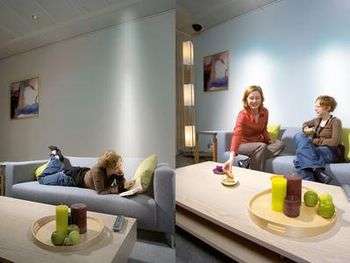December 5, 2007 weblog
Philips Lighting The Way Through the 21st Century

Philips scientists envision a future of eco-friendly and aesthetic lighting solutions for consumers. Their R&D work in the area of OLED lighting will bring light to walls, ceiling, furniture, windows and most surfaces. The lighting effects that will be created by this new technology are revolutionary.
Royal Philips Electronics of the Netherlands, the "sense and simplicity" company has monumental changes in store for consumers in the area of lighting solutions. Philips Lighting has dedicated significant resources to research and development.
Imagine a future of energy-saving lighting solutions that will transform a basic room into visual masterpiece. Walls and ceilings that are illuminated according to the personal preference of the user. The future Philips promises is simply perfection. No more bulky table lamps with ordinary bulb shape illumination. Philips is creating visual ambiance in lighting that can be adjusted for all moods and purposes.
Philips Sense of the Aesthetics:
Philips is in the research and development stage of presenting organic emitting lighting diodes, (OLEDs) that will illuminate walls, ceilings, windows and change interior lighting forever. The light source is evenly distributed throughout the large surface and can produce color glows in the ceiling and the walls. Glass walls that light up at the flick of a switch and can be adjusted to dim or brighten according to the consumers desired effect.
The OLED is the lighting solution of the future. It is not only Eco-friendly, but it has a wide range of adaptations for the home, commercial and multi-dwelling environments. Currently, OLED is used for decorative lighting purposes only. Its application for creating illumination to entire environments is about three to five years in the future.
Differentiating OLED From Other Light Sources:
The scientists at Philips have been working on the uses of OLED since 1991 and intensified its efforts in the lighting solutions area in the past several years. OLED works by passing electricity through one or more very thin layers of organic semiconductive layers. These layers are sandwiched between a negatively charged layer of aluminum and a positively charged transparant layer of indium tin oxide.
The next step in the process involves attaching the entire sandwiched unit to a transparant surface or glass. When an electric current is applied to the aluminum layer, it is conducted to the positive layer through the organic layer. As the current passes though the film, it emits light. Depending on different materials in the film, a range of color emitting light appear.
Current Prototypes of OLED & Future Plans:
The first place consumers will see the use of Philips OLED technology will be in the area of decorative items. Currently, OLED prototype colored panels are in the size range of 5cm x 5cm to 15cm x 15cm. As the technology develops Philip´s scientists envision panels of 60cm x 60cm. Philips has developed warm white panels and plain white panels that may be adjusted for brightness and effect. The colored light emitting panels offer ambiant light that mimics daylight or traditional lighting. This latter innovation is about three to five years away.
In the future ordinary windows will be transformed by transparant OLED panels that will act as ordinary windows during the day and at night generate either natural light or be adjusted to create exquisite interior lighting effects. An additional use of the OLED window panels will be to provide a security shield for home and offices.
Philips' scientist are hard at work to develop a flexible OLED light that can be moulded to fit on virtually any surface. Currently, the OLED is mounted on glass. The future development of plastic substrates that will allow OLED to be applied to almost any type of surface will then allow OLED to take the next giant step in lighting solutions. This solution will allow OLED to be used on walls, ceiling, furniture and and almost any surface. This lighting solution is about five to eight years in the future.
About Philips:
Philips Lighting employes nearly 48,000 employees world-wide. Philips has announced an agreement to acquired North American luminary giant Genlyte Group Inc. In addition to the Lighting businesses, Philips is a leader in consumer products, medical systems, domestic appliances and personal care. In addition, Philips has 30 strategic partnerships with other companies.
In keeping with its brand identity, Philips plans to simplify its corporate structure. Starting January 1, 2008, Philips will reorganize its entities into three market sectors. The Philips Lighting, Philips Healthcare and Philips Consumer Lifestyle will be subsumed the various entities into a more sensible and simple structure.





















